Chestnut
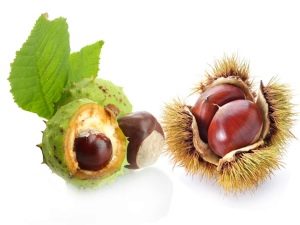
Chestnut is a tree that everyone has heard of, but not everyone knows about its amazing properties and features. In this article, you will learn about the incredible benefits of this tree, discover its healing properties, learn how to identify edible chestnut fruits by their appearance and be sure to want to try them.
In this article, the main place is given to the edible chestnut. But horse chestnut, which is well known to the inhabitants of the European part of Russia, will also be mentioned.
Appearance
Sowing chestnut has several names: edible, noble, real. Beech family, genus Chestnut.
Deciduous tree. Its height reaches 35 m, and the circumference of the trunk is 2 m. The bark is thick, brown in color with deep longitudinal cracks.

The leaves are sharp-toothed, up to 30 cm long. In summer, the leaves are yellowish-green, and in autumn they become bright yellow. Inflorescences of light yellow or green color resemble long narrow catkins, in the lower part of which there are female branches, and in the upper part - male ones.

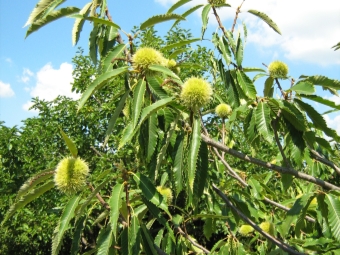
Chestnut fruits are edible nuts that ripen in brown cupules, protected on the outside by numerous long spines, and covered with silky felt inside.In each cupule, 1-4 rounded or flattened nuts with a smooth, shiny surface of dark brown color ripen.
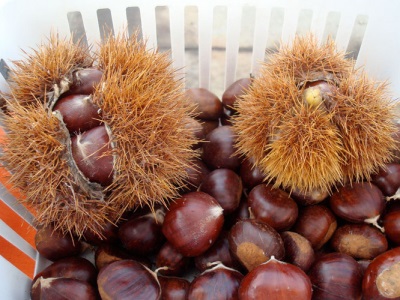
How to distinguish edible from inedible
Also in nature there are inedible chestnuts. The most famous is horse chestnut. It belongs to the Sapindov family, a subfamily of Horse chestnuts.
The main differences between horse and edible chestnuts:
Leaf shape and size.
- inflorescences;
- the taste of fruits: in horse chestnut they are bitter, in sowing chestnut they are sweetish;
- the number of fruits in the nut.
- the outer shell of the plush: in horse chestnut it is bright green in color with small tubercles, and in sowing chestnut it is brown, with long spikes.




The only similarity between horse chestnut and sowing chestnut is the external similarity of the fruits: they are dark brown in color, with a smooth, shiny surface, decorated with a light spot.
Types of edible chestnuts
There are about 30 species of chestnut trees and shrubs in the world.
The most popular types of sowing chestnut, the fruits of which can be eaten, are:
- European seed;
- Japanese, or city;
- Chinese softest.
Each species differs from each other in habitat, trunk height, size and shape of leaves and fruits, flowering and fruiting.



Where does it grow?
Edible chestnut is a tree with a capricious character. For a rich harvest, this fastidious crop needs a warm climate, air humidity of at least 70% and slightly acidic, moist soil.
Chestnut does not withstand well not only drought and summer heat, but also a decrease in air temperature in spring and summer. He loves the light, but this does not prevent him from growing in the shade.
In Russia, these chestnuts can only be found in the Krasnodar Territory. It also grows on the territory of Armenia and Azerbaijan.But chestnut fruits from these areas rarely reach the size of even a walnut.
Things are quite different in Italy, France and Spain. The fruits of European chestnuts grow to the size of a large mandarin, as the climate and soils of these countries are ideal for this wonderful tree. The edible chestnut is also cultivated in southern Ukraine, the Balkans, East Asia and the Atlantic coast of the United States.

Collection and storage
The harvest from one adult tree is from 60 to 200 kg. Fruiting begins from 3-15 years.
By the time of full ripening, chestnut fruits contain the maximum amount of nutrients. The degree of maturity can be determined by the color of the fruit - they become dark brown. This is the perfect time to start collecting.
The fruits are harvested before they fall from the tree, by the time they are almost fully developed:
- Plyuski with nuts are knocked down from the tree with long poles, having previously cleared the soil under the tree from branches and leaves. It is also possible to collect mature chestnuts that have fallen from the tree on their own.
- Then the nuts are separated from the bun and immediately placed for ripening in a room with low humidity and good ventilation.
- The final step is sorting. Nuts spoiled by fungi and parasites are excluded here, the rest are sorted into three commercial grades, based on their size and quality.
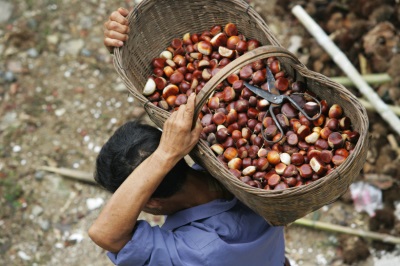
Freshly picked chestnuts are much more valuable than dried ones. They contain a maximum of useful substances, and they are also more pleasant to the taste. Storage of fruits of a fresh crop is permissible only at a temperature close to zero.
For the purpose of long-term storage, the collected nuts are dried in the open sun, or in special dryers and placed in dry, well-ventilated rooms.
Leaves are harvested in August - September. They should be no more than 20 cm in length. Then they are laid out in loose layers and dried in shaded places. Storage takes place in cardboard containers or linen bags and always in a dry room.
How to choose and where to buy
The edible chestnut season runs from August to November. At this time, fresh chestnut fruits and seeds can be purchased in the markets, as well as in supermarkets. Fresh chestnuts have a short shelf life and spoil quickly. Pickled or frozen chestnuts are available throughout the year.
When choosing edible chestnut fruits, pay attention to:
- For shape and size. Nuts should be large, the same size;
- For weight and hardness. Quality chestnuts are heavy and firm;
- To the surface. Nuts should be glossy, dark brown.
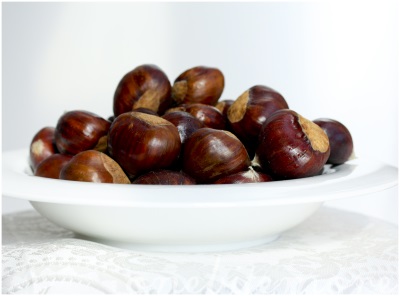
When buying edible chestnuts from the market, make sure you buy them. The seeds and fruits of the horse chestnut, which is unfit for human consumption, are also sold in the markets.
Characteristics of the edible species
- fresh fruits have a sweet, pleasant taste;
- after heat treatment, the taste of the fruits resembles potatoes;
- beginning of flowering: June, July;
- the first flowering occurs at 3-12 years of age;
- the diameter of a mature plush in forest chestnuts is up to 6 cm, in cultivated chestnuts - up to 10 cm.
Nutritional value and calories
The fruits of the sowing chestnut are a unique food product. They have a high energy value and are very nutritious. Due to their lower fat content than other nuts, chestnuts are considered healthier and less oily.
In 100 gr. fresh nuts contain:
- proteins - 1.6 grams;
- fats - 1.25 grams;
- carbohydrates - 44 grams.
Calorie chestnut fruit:
- fried - 182 kcal / 100 gr;
- fresh - 166 kcal / 100 gr;
- stewed or boiled - 131 kcal / 100 gr;
- for a couple - 56 kcal / 100 gr.
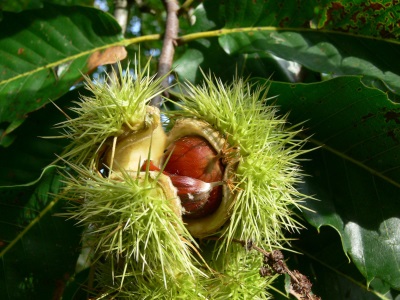
Chemical composition
Edible chestnut fruits contain:
- carbohydrates - up to 62%;
- proteins - up to 6%;
- fats - up to 5%;
- various trace elements: titanium, molybdenum, cobalt, barium, fluorine, aluminum, zinc, copper;
- essential mineral salts; phosphorus, magnesium, calcium, sodium, potassium;
- fiber - from 2.5 to 3.5%;
- sugar - up to 17%;
- various vitamins - B1 and B2, C, PP, A;
- acids: lactic, citric, malic;
- tannins;
- oils;
- pectins;
- flavonoids.
The content of sugar and other beneficial substances increases over time and usually reaches a maximum a few weeks before harvest.
The bark of the trunk and branches of the edible chestnut contains:
- glycosides;
- oils;
- tannins.
Edible chestnut leaves contain:
- glycosides;
- pectins;
- routine;
- vitamin K;
- vitamin C;
- flavone compounds;
- tannins.
Beneficial features
Chestnut has earned the love of a person not only because of its beauty and delicious taste of the fruit. The amazing abilities of this tree have been discovered for a long time.
Edible chestnut has a beneficial effect on human health, as it has the following medicinal properties:
- anti-inflammatory;
- antitussive;
- wound healing;
- painkiller;
- antipyretic;
- astringent;
- hemostatic;
- diuretic;
- saturation of the body with proteins, carbohydrates, vitamins, fiber and minerals.
See the next video for more on edible chestnuts.
Horse chestnut has more powerful healing properties. The spectrum of its action is the widest and is used as such means as:
- anti-inflammatory;
- decongestant;
- anticonvulsant;
- venotonic;
- hemostatic;
- astringent;
- bactericidal;
- wound healing;
- debilitating;
- sedative;
- antioxidant;
- antitumor;
- tonic;
- diuretic;
- diaphoretic;
- antipyretic;
- antithrombotic;
- anti-sclerotic;
- immuno-strengthening.

Harm
Despite such an impressive list of useful properties of chestnut, it is necessary to say about the contraindications and possible harm that can be done to your health by eating chestnut fruits or using medicines based on this plant.
When eating chestnuts, the following complications may occur:
- violation of the digestive tract due to excessive use: constipation, diarrhea, bloating.
- convulsions;
- exacerbation of diseases of the gastrointestinal tract, blood, liver and kidneys;
- allergic reactions.
Contraindications
Contraindications to the use of edible chestnut in dosage form and as a food product:
- individual intolerance;
- hypotension;
- reduced blood clotting;
- overweight;
- chronic renal failure;
- pregnancy and breastfeeding (due to the risk of allergic reactions);
- diabetes mellitus is a contraindication for the use of chestnut honey.
- menstrual irregularities.
Also, eating horse chestnut fruits can cause harm to health, when a person unknowingly takes them for edible chestnuts. In case of poisoning, nausea appears and digestion is disturbed. It is also possible the occurrence of allergic reactions with the external use of horse chestnut.
Oil
Since the flesh of the chestnut contains little fat, it is impossible to obtain a large amount of oil from it. Chestnut oil is used in cosmetology for the production of creams and shampoos.
Chestnut oil cares for dry hair and protects it from drying out. It is also used to care for oily skin, restoring its balance. Chestnut oil is able to protect the skin from ultraviolet radiation.

Application
In cooking
Taste and useful qualities of a chestnut nut have made it very popular in the food industry and cookery. As a source of vegetable protein, vegetarians include chestnuts in their diet.
Edible chestnut fruit:
- eaten raw, boiled, stewed, smoked or fried;
- ground into flour and coffee drink;
- grated is used to make marzipan and chocolate;
- processed into alcohol.
Chestnut nuts are a real find for creating both modest dishes and gourmet ones. In the kitchen it is used as:
- seasoning, filling and side dish for meat dishes;
- addition to first courses;
- seasoning for wheat and oatmeal;
- chestnut paste for making toast and sandwiches;
- component for the preparation of confectionery and bakery products, pasta and various desserts;
- variety of standalone meals.
How to bake chestnuts in the oven, see the following video.
Souffle
250 gr. chestnuts are peeled and blanched. Next, cut the nuts into thin slices, lower them into 200 ml. boiling milk and cook for 25 minutes. At the end of cooking, hot chestnuts are rubbed through a sieve.
Two yolks are ground with 50 gr. sugar, add vanillin, cinnamon and 20 gr. liquor and mixed with chestnut puree. Then two well-whipped proteins are gradually introduced into the dough and everything is mixed.
Grease a souffle mold with oil, sprinkle with flour and spread the resulting mass. Then they are sent to the oven, heated to 200 degrees, for 20-25 minutes. The finished dish is taken out of the mold, sprinkled with powdered sugar and immediately served.

French cream soup
500 gr. Peeled chestnuts are boiled over high heat for 5 minutes, then the skin is removed from them and lowered into 1 liter of boiling meat broth. One onion is sautéed in butter and two grated carrots and one turnip (or celery) are added to it.
Put the vegetables in a saucepan, add salt and cook for another 10 minutes. until the chestnuts are done. Allow the soup to cool slightly and beat it with a blender. Before serving, season with sour cream and garnish with dill or other herbs.
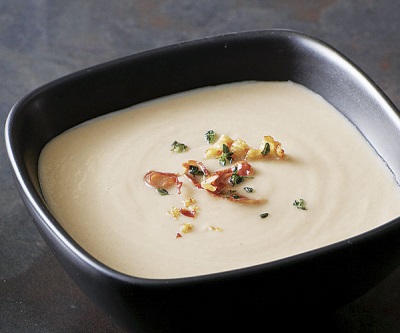
In medicine
The role of edible chestnut in medicine is also invaluable.
Parts of the tree are used fresh and dried in the form of infusions, decoctions and alcoholic tinctures for the treatment of many diseases:
- inflammatory processes of the upper respiratory tract;
- whooping cough;
- varicose veins;
- diseases of the stomach and intestines;
- edema associated with kidney disease;
- epistaxis;
- wounds and cuts;
- abscesses and boils;
- wounds and cuts;
- catarrh of the bladder and dysentery;
- expansion of the veins of the anus and rectum;
- dilated veins of the nasopharynx;
- painful menstruation;
- climax.
Flowers for painful menstruation
Dilute 30 drops of juice from chestnut blossoms with two teaspoons of water and take twice a day.
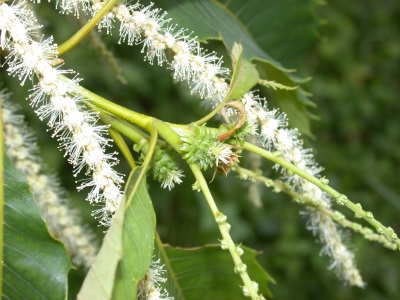
Leaves for severe cough and whooping cough
A mixture of two teaspoons of crushed chestnut leaves and 250 ml. Bring water to a boil and cook for 3-5 minutes. Then filter and take a sip during the day.
chestnut honey
Separately, it must be said about chestnut bee honey: rare and incredibly useful. Its taste is specific: tart and bitter. But its healing properties are undeniable. It saturates the body with vitamins B, C and D, enzymes, various amino acids, as well as calcium, manganese, iron and copper.
Chestnut honey is used:
- as a prevention of gastrointestinal diseases, to improve appetite and stimulate bile secretion;
- with asthma, bronchitis, tonsillitis and other respiratory diseases;
- to strengthen the organs of the cardiovascular system, as well as normalize blood pressure;
- with disorders of the nervous system, as it has a calming and relaxing effect;
- for various skin lesions as an antibacterial agent.
To eliminate the bitterness in the taste of chestnut honey, you need to warm it up a little on the fire. But in this case, all valuable properties will be lost. Chestnut honey does not crystallize and can be stored for up to three years.

Horse chestnut in medicine
The medicinal properties of horse chestnut have long been used in alternative medicine, and are also widely used in pharmaceuticals.
Medicines and traditional medicine based on horse chestnut help with the following diseases:
- varicose veins and varicose ulcers;
- sinusitis;
- haemorrhoids;
- arthritic and rheumatic pains;
- diarrhea;
- malaria;
- uterine bleeding;
- salts and radionuclides in the body.

Fruit decoction bath
A bath with a decoction of horse chestnut fruits is effective for the treatment of mastopathy, varicose veins, peripheral circulation disorders, hemorrhoids, rheumatism, thrombophlebitis and vasospasm.
One kilogram of fruits and 5 liters of water are brought to a boil, and then boiled over low heat for 30 minutes. The resulting broth is filtered, poured into a bath, where it cools to 37-38 degrees. Such a bath is taken for 10-15 minutes before going to bed. Course - 10 - 12 baths, daily or every other day.
Infusion of fruits on the water
Take 2 tbsp. chopped fruits of horse chestnut, pour boiling water. Put in a water bath for 15 minutes.Strain the broth and take 2 tbsp. 4 times a day for the following diseases:
- cough,
- bronchitis,
- diarrhea
- inflammation of the kidneys.
Treat until you recover.

Oil for varicose veins, bruises
5 tbsp crushed fruits pour 0.5 liters. vegetable oil. Put in a water bath for 1 hour. Cool and strain. Rub 2-3 times a day on problem areas.
Treat until you recover.
Alcohol tincture on flowers
Put fresh horse chestnut flowers in a bottle at 1/3 volume, top up with alcohol and cork well. Insist 1 month in a dark warm place. Shake daily. Strain. Place in refrigerator for storage.
Rub into problem areas for the following diseases:
- exchange polyarthritis,
- gout,
- rheumatism,
- sciatica,
- osteochondrosis.
Ingestion is carried out at 1.5 tsp. 3 times a day with the addition of boiled water 30 minutes before meals. The course of treatment is 2-4 weeks.

Fruit tincture of alcohol
30 pcs. fruits of horse chestnut peeled and chopped, pour 0.5 l. vodka. Cork and put for 1 week in a dark place. Strain.
Rub into problem areas 2-3 times a day. The course of treatment is 1-2 months.
Inside, the tincture is taken with the addition of boiled water, 20 drops 3 times a day 30 minutes before meals. The course of treatment is 4-8 weeks.
Medicinal properties of this tincture:
- thins the blood
- with varicose veins,
- thrombophlebitis,
- bruises,
- gcmorroe,
- hypertension,
- sciatica,
- arthrosis,
- osteochondrosis,
- ligament stretching.
Infusion of bark on water
1/2 member chopped bark of horse cashew pour 1 tbsp. boiled water at room temperature. Insist 8 hours, strain. Take an infusion 3-4 times a day, 2 tbsp. 30 minutes before meals for the following diseases:
- hemorrhoids (applied both internally and externally),
- lung and bronchial diseases
- diarrhea
- back diseases (applied both internally and externally),
- runny nose,
- internal bleeding,
- gout,
- rheumatism.
The course of treatment is from 1 to 4 weeks, depending on the disease.

Sitz bath for hemorrhoids
50 gr. horse chestnut bark or branches pour 3 liters. water and bring to a boil. Cook for 15-20 minutes. Strain and pour into a bath of cool water.
Before going to bed, after emptying the bowels, take a bath for 15 minutes. The course of treatment is 2 weeks.
Take 1 tsp at the same time. juice or alcoholic tincture of flowers, diluted with water, 2 times a day during the entire course of treatment.
Treatment of sinusitis
Peel fresh horse chestnut fruit. Shape the fetus into a "pencil" sized to fit in the nostril. Lubricate the "pencil" with honey and insert into the nostril.
After 5 minutes, there will be a burning sensation, sneezing. Lots of mucus will come out. Remove the pencil immediately and insert it into the other nostril, leave it until mucus is released.
The procedure is done every other day until recovery. Every time you need to use fresh chestnuts.
The remedy is used on initial diseases in addition to the appointments of the attending physician.
Attention! A prerequisite for the use of chestnut as a medicine is to consult a doctor.
In production
Chestnut wood is highly valued in construction and furniture production due to its strength, aesthetic appearance and resistance to various fungi. It is more durable than oak, so it is recognized as the best for making barrels for aging wine.
Leaves, bark and puffs act as raw materials for obtaining natural dyes and extracts for vegetable tanning of leather.
Extracted chestnut chips are used in pulp production, and chestnut oil has been used in soap making.

At home
In everyday life, chestnut trees are used as a decorative element for garden and summer cottages. Often chestnut is grown at home.
Varieties
There are over 400 crops suitable for cultivation. The most common varieties are:
- Large-fruited. Fruit weight - 7-12 g. Grows in Azerbaijan;
- Small-fruited. Fruit weight - 4.5-6.5 g. Grows in Azerbaijan;
- Lyon, Storm de Lilyak, Neapolitan. Fruit weight - 20-60 g. Cultivated in Italy, southern France and the Iberian Peninsula.
Chestnuts with large fruits in the natural environment are not found.
About the red-colored chestnut, which is not afraid of the chestnut moth, see the following video.
Cultivation and care
For the cultivation of seed chestnut, certain climatic conditions and soil composition are necessary. However, there are edible chestnut cultivars adapted for wintering that are grown in temperate climates.
There are several ways to grow chestnuts:
- seedlings;
- seeds in spring;
- seeds in autumn.
seedlings
For the first method, you need to purchase chestnut seedlings. This can be done at flower markets, but to be completely sure of their quality, it is recommended to contact a specialized nursery.
For planting, a special soil substrate is used, consisting of forest land (50%), humus (50%), special dolomite flour and slaked lime, 0.5 kg per 50 cm3. This mass is placed in the ground, seedlings are planted to a depth of about 10 cm and watered abundantly with water at a comfortable temperature. Keep in mind that for the best fruiting, one seedling needs an area of \u200b\u200babout 3 meters in diameter.
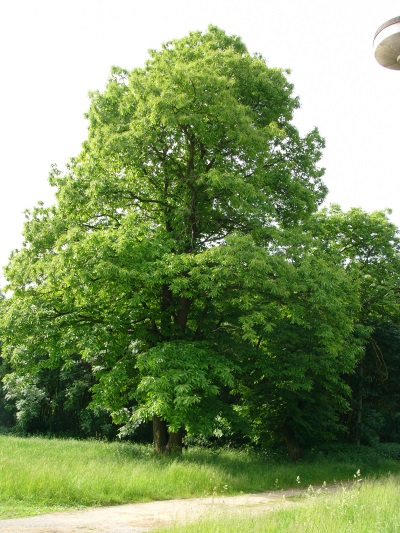
Seeds in spring
For the spring method of cultivation, the fruits of the last harvest are used, which were kept in temperature conditions from + 5 to 6 ° C for 5 months. Five days before planting in the ground, it is necessary to soak the fruits in warm water. Then their shell swells, and inside the process of development of the embryo begins. Then these seeds are planted in the ground without shelter.
Seeds in autumn
For the autumn growing method, crumbled nuts are collected and a stratification procedure is carried out. The fruits are placed in an open container and sprinkled with sand, and then removed in the cold for 10-12 days. The best temperature regime for seed stratification: from + 5 to 6 °С.
After that, the seeds are planted in well-moistened soil to a depth of 5 or 6 cm, every 10 or 15 cm, and are covered with fallen leaves from above. In the spring it is necessary to thin out the seedlings.
Care
When caring for a chestnut tree, produce:
- watering young trees as the soil dries;
- single fertilizer in early spring;
- loosening the soil 2 or 3 times during the season;
- mulching the soil around the trunk with fallen leaves, sawdust or peat.
For the benefits of chestnut, see the following video.
Interesting Facts
- the beams of the famous Cathedral of Notre Dame in Reims are made of Colchis chestnut wood;
- during the reign of Alexander the Great, the army's food supplies were provided by crops from numerous chestnut groves that were planted specifically for these needs;
- more than 75% of the world production of chestnut nuts comes from China (69%) and Korea (7%). The share of Russia is 2%;
- the life of the seed chestnut under optimal conditions is 500 years or more;
- spiders never weave webs in buildings made of this wood.Thanks to this valuable property, chestnut wood beams were used to build most of the medieval castles in Europe;
- edible chestnut nuts cooked on fire are eaten hot and washed down with grape juice. This combination is the most perfect for gourmets;
- horse chestnut flowers are endowed with valuable properties only the first 2 days of flowering.


















Oh, now I know how to distinguish an edible chestnut from an inedible one! Thank you!
And I have been making alcohol tincture for a long time. I saw chestnuts blooming red in Switzerland - a magnificent sight!